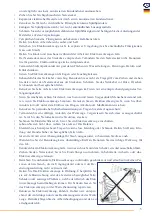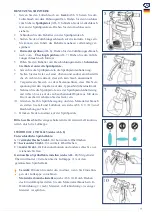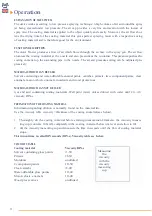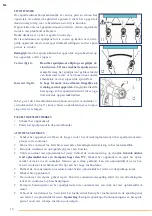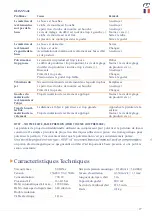
12
|
GB
Coating material
Viscosity DIN-s
Measuring
the
viscosity
with the
viscosity
measuring
cup
Solvent containing gloss paints
15-50
Primers
25-50
Mordants
undiluted
2 component paints
20-50
Clear varnishs
15-40
Water-dilutable gloss paints
20-40
Motor-vehicle enamels
20-40
Wood presevatives
undiluted
Operation
EXPLANATION OF THE SYSTEM
The device works according to low-pressure spraying technique. A high volume of air surround the spray
jet being ejected under low pressure. The air cap provides a very fine atomization with the lowest of
spray mist .The coating material is applied to the object quickly and exactly. Moreover, the air flow shor-
tens the drying time for the coating material .this gives perfect spraying result with a respective saving
of coating material and is therefore good for the environment.
FUNCTION DESCRIPTION
The motor blower produces a flow of air which flows through the air hose to the spray gun. The air flow
atomizes the coating material at the nozzle and also pressurizes the container. This pressure pushes the
coating material up the ascending pipe to the nozzle. The air and pressure setting can be adjusted pro-
gressively.
MATERIALS WHICH CAN BE USED
Solvent containing and water-dilutable enamel paints, vanishes, primers, two-component paints, clear
enamels, motor-vehicle enamels, mordants and wood protectives.
MATERIALS WHICH CANNOT BE USED
Lyes and acid containing coating materials. Wall paint (latex) unless diluted with water until 20 – 40
viscosity DIN-s.
PREPARATION OF THE COATING MATERIAL
Information regarding dilution is normally found on the material tin.
Use the viscosity table viscosity =thickness of the coating material (see below).
1. Thoroughly stir the coating material before starting measurement. Immerse the viscosity measu-
ring cup (contents 100cm3).completely in the coating material below rim level and allow to fill.
2. Lift the viscosity measuring cup and measure the time in seconds until the flow of coating material
stops.
This runout time is called DIN seconds (DIN-s). Viscosity table see below.
VISCOSITY TABLE





